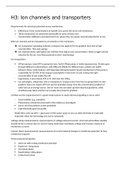H3: Ion channels and transporters
Requirements for electrical potentials across membranes:
1. Differences in the concentrations of specific ions across the nerve cell membranes
2. These membranes are selectively permeable to some of these ions
- Concentration (diffusion) and electrical force, where they are equal; reversal potential for an ion.
Both ion channels and ion transporters are proteins in the membrane.
Ion transporters (pumping stations); transport ions against the ion gradient form low to high
concentration. This costs energy.
Ion channels (lock); open gates ions will flow from high to low concentration. Need a trigger and be
selective for the ion. Ions flow passively so don’t need energy.
Ion transporters:
ATPase pumps, need ATP to pump the ions. Na/K ATPase pump, is really important one. Protein goes
through different conformations, with different affinity for different ions, protein can switch
between these conformations. ATP dependent phosphorylation (pump mechanism) of the pump is
responsible for 20-40% of the energy consumption in the brain! So just to keep the right
concentration of ions inside the cell.
- Experiment: If you remove ATP or K+ then less Na+ efflux.
Ion exchangers: antiporters and co-transporters. Energy comes from the ion going down his own
gradient. Does not require ATP but use the potential energy from the concentration gradient of
other ions as an energy source. One or more ions are taken up their electrical gradients, while
simultaneously taken another ion (usually Na+) down its gradient.
3) What are the requirements for a good model system to study electrical signalling in nerve cells?
- Good visibility (e.g. zebrafish)
- Phenomenon should be preserved in the model you investigate
Nerve cell that produces action potentials
Experimentally good accessible
Model they came up with -> giant axon of the squid. Large so you can stick electrode in (especially
important when the technology was not so advanced).
Voltage-clamp measurements: measurements of voltage-induced currents. Intra and extracellular solution
should not be in contact also no current clamp. Determine membrane voltage and measure response in
membrane currents.
Current clamp measurements: measurements of current-induced changes in membrane potential. Se how
membrane response.
Action potential properties
Start out with resting membrane potential
Rapid rise: rising phase
Overshoot phase
Rapid falling: falling phase
Undershoot phase
Requirements for electrical potentials across membranes:
1. Differences in the concentrations of specific ions across the nerve cell membranes
2. These membranes are selectively permeable to some of these ions
- Concentration (diffusion) and electrical force, where they are equal; reversal potential for an ion.
Both ion channels and ion transporters are proteins in the membrane.
Ion transporters (pumping stations); transport ions against the ion gradient form low to high
concentration. This costs energy.
Ion channels (lock); open gates ions will flow from high to low concentration. Need a trigger and be
selective for the ion. Ions flow passively so don’t need energy.
Ion transporters:
ATPase pumps, need ATP to pump the ions. Na/K ATPase pump, is really important one. Protein goes
through different conformations, with different affinity for different ions, protein can switch
between these conformations. ATP dependent phosphorylation (pump mechanism) of the pump is
responsible for 20-40% of the energy consumption in the brain! So just to keep the right
concentration of ions inside the cell.
- Experiment: If you remove ATP or K+ then less Na+ efflux.
Ion exchangers: antiporters and co-transporters. Energy comes from the ion going down his own
gradient. Does not require ATP but use the potential energy from the concentration gradient of
other ions as an energy source. One or more ions are taken up their electrical gradients, while
simultaneously taken another ion (usually Na+) down its gradient.
3) What are the requirements for a good model system to study electrical signalling in nerve cells?
- Good visibility (e.g. zebrafish)
- Phenomenon should be preserved in the model you investigate
Nerve cell that produces action potentials
Experimentally good accessible
Model they came up with -> giant axon of the squid. Large so you can stick electrode in (especially
important when the technology was not so advanced).
Voltage-clamp measurements: measurements of voltage-induced currents. Intra and extracellular solution
should not be in contact also no current clamp. Determine membrane voltage and measure response in
membrane currents.
Current clamp measurements: measurements of current-induced changes in membrane potential. Se how
membrane response.
Action potential properties
Start out with resting membrane potential
Rapid rise: rising phase
Overshoot phase
Rapid falling: falling phase
Undershoot phase



